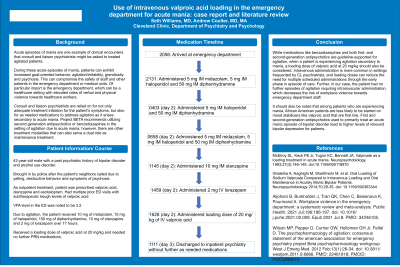Psychopharmacology and Toxicology
Session: Poster Session
(149) Use of Intravenous Valproic Acid Loading in the Emergency Department for Acute Mania: Case Report and Literature Review
Location: Griffin Hall

Trainee Involvement: Yes
- SW
Seth Williams, MD
Resident Physician
Cleveland Clinic
Cleveland, Ohio, United States - AC
Andrew Coulter, MD, MA
Associate Staff
Cleveland Clinic Foundation
Cleveland, Ohio, United States
Presenting Author(s)
Co-Author(s)
Introduction: Consult and liaison psychiatrists regularly see patients with a prior history of bipolar disorder and behavioral disturbances associated with mania. During manic episodes, patients can be disruptive, intrusive, grandiose, and psychotic with increased goal-oriented behavior/inability to maintain their safety and safety of others in the emergency department. Due to this, effective management of agitation is necessary to maintain staff safety as well as treat the underlying mood disorder.
Case Presentation: The case presented is a 42-year-old male with a past psychiatric history of Bipolar I Disorder and alcohol use disorder who was brought to the emergency department from his apartment to due to aggressive behaviors and reported to be labile and yelling and exhibiting psychotic behaviors. He was on valproic acid, quetiapine and escitalopram per his outpatient provider, with noted past ED visits showing a subtherapeutic Depakote level. He was noted to be extremely agitated upon arrival to the ED, paranoid and hitting objects in his room. Over a span of 17 hours, the patient was administered 10 mg of midazolam, 15 mg of haloperidol, 150 mg of diphenhydramine, 10 mg of olanzapine and 2 mg of lorazepam.
The patient was discovered to have a VPA level of 3.2. Due to his continued agitation, the patient was given a loading dose of IV valproic acid at 20 mg/kg. After administration of this loading dose, the patient was noted to have decreased levels of agitation and did not require any further PRN medication. He was safely able to be transferred to an inpatient psychiatric facility.
Discussion/
Conclusion: Mania can lead to severe agitation requiring multiple PRN medications, especially when the presentation is accompanied with psychotic features and paranoia. In patients whose agitation is poorly controlled with first-line agitation management, clinicians should consider a loading dose of valproic acid which is effective for agitation as well as acute mania. This can lead improved staff and patient safety in emergency departments while patients await medical clearance for transfer to inpatient psychiatric units, and initiate appropriate treatment for mania in this liminal period.
(It should also be considered above other means of agitation management like second generation antipsychotics as this can lead to better control of patient’s symptoms. Also, it is clearly noted in studies that African American patients, bipolar disorder presenting as mania is not treated as frequently with first line mood stabilizers such as Depakote, leading to management with first- and second-generation antipsychotics which have been shown to have mood instability with higher levels of bipolar depression after resolution of manic episodes.)
References:
1. McElroy SL, Keck PE Jr, Tugrul KC, Bennett JA. Valproate as a loading treatment in acute mania. Neuropsychobiology. 1993;27(3):146-149. doi:10.1159/000118970
2. Ghaleiha A, Haghighi M, Sharifmehr M, et al. Oral Loading of Sodium Valproate Compared to Intravenous Loading and Oral Maintenance in Acutely Manic Bipolar Patients. Neuropsychobiology 2014;70:29-35. doi: 10.1159/000363344
Case Presentation: The case presented is a 42-year-old male with a past psychiatric history of Bipolar I Disorder and alcohol use disorder who was brought to the emergency department from his apartment to due to aggressive behaviors and reported to be labile and yelling and exhibiting psychotic behaviors. He was on valproic acid, quetiapine and escitalopram per his outpatient provider, with noted past ED visits showing a subtherapeutic Depakote level. He was noted to be extremely agitated upon arrival to the ED, paranoid and hitting objects in his room. Over a span of 17 hours, the patient was administered 10 mg of midazolam, 15 mg of haloperidol, 150 mg of diphenhydramine, 10 mg of olanzapine and 2 mg of lorazepam.
The patient was discovered to have a VPA level of 3.2. Due to his continued agitation, the patient was given a loading dose of IV valproic acid at 20 mg/kg. After administration of this loading dose, the patient was noted to have decreased levels of agitation and did not require any further PRN medication. He was safely able to be transferred to an inpatient psychiatric facility.
Discussion/
Conclusion: Mania can lead to severe agitation requiring multiple PRN medications, especially when the presentation is accompanied with psychotic features and paranoia. In patients whose agitation is poorly controlled with first-line agitation management, clinicians should consider a loading dose of valproic acid which is effective for agitation as well as acute mania. This can lead improved staff and patient safety in emergency departments while patients await medical clearance for transfer to inpatient psychiatric units, and initiate appropriate treatment for mania in this liminal period.
(It should also be considered above other means of agitation management like second generation antipsychotics as this can lead to better control of patient’s symptoms. Also, it is clearly noted in studies that African American patients, bipolar disorder presenting as mania is not treated as frequently with first line mood stabilizers such as Depakote, leading to management with first- and second-generation antipsychotics which have been shown to have mood instability with higher levels of bipolar depression after resolution of manic episodes.)
References:
1. McElroy SL, Keck PE Jr, Tugrul KC, Bennett JA. Valproate as a loading treatment in acute mania. Neuropsychobiology. 1993;27(3):146-149. doi:10.1159/000118970
2. Ghaleiha A, Haghighi M, Sharifmehr M, et al. Oral Loading of Sodium Valproate Compared to Intravenous Loading and Oral Maintenance in Acutely Manic Bipolar Patients. Neuropsychobiology 2014;70:29-35. doi: 10.1159/000363344

